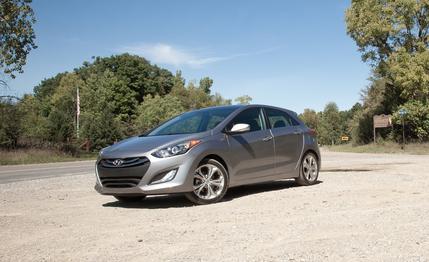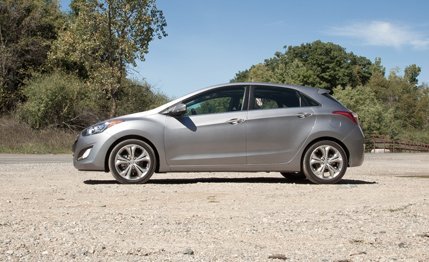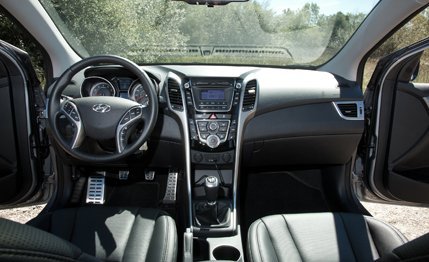
 Instrumented Test
Instrumented Test


Hyundai’s Elantra is a solid player in the crowded compact-car competition, but it has faced self-imposed limitations, lacking the nifty hatchback variants offered by competitors such as the Ford Focus, Mazda 3, and Subaru Impreza. The deceased Elantra Touring wagon nibbled at this turf but lacked the svelte looks and desirability of many of its five-door rivals.
One of three body styles stirred into the Elantra mix—including a coupe variant—the GT represents yet another snappy interpretation of Hyundai’s latest design language. Yet aside from the front fascia, it bears little resemblance to the other Elantras.
The front end is set off by Mazda-esque wheel arches that seem more pronounced than those on the sedan; the roofline—punctuated by an optional double sunroof of vast dimensions—slopes back to a forward-canted hatch and wraparound LED taillights. There’s considerable structural commonality with the standard Elantra, but most of what’s visible is unique to the GT.


The GT’s dimensions differ considerably from those of its four-door sibling. The 104.3-inch wheelbase is two inches shorter than the sedan’s, and the GT’s 169.3-inch overall length is nine inches less than that of the four-door. The width—70.1 inches—is about the same, although the GT is a bit taller: 57.9 inches versus 56.5. The GT’s dimensions are positively European, which makes sense, given that the GT is sold there as the i30.
The Inside Job


The GT’s interior appointments and trim are similar to the sedan’s, which is to say attractive and of high quality. As with other current Hyundais, there’s a pile of standard equipment baked into the $19,170 base price. Examples: heated mirrors and front seats, remote keyless entry, air conditioning that also cools the glove box, cruise control, driver-selectable steering modes, Hyundai’s Blue Link telematics, satellite radio, fog lights, a USB port and aux input, a six-speed manual, and 16-inch aluminum wheels.
There are two option groups—the performance-oriented Style package ($2750) and the Tech package ($2350). The former was fitted to our test car and adds 17-inch aluminum wheels, slightly firmer suspension tuning, the double sunroof, leather seats, a leather-wrapped steering wheel, a power driver’s seat, aluminum pedal cladding, and auto up-and-down control for the driver’s window. The Tech gear includes a nav system, a rearview camera (the lens lurks behind the logo in the middle of the rear hatch), auto headlights, dual-zone auto climate control, and proximity-key entry and start.


Hatchbacks are all about interior versatility, and the GT measures up well in this regard. There’s a shallow storage bin under the cargo floor, and the 60/40-split rear seatbacks and seat bottoms flop out of the way to expand the space for stuff from 23 cubic feet to 51. Both numbers are near the top of the charts versus the GT’s competitors, and rear-seat legroom is respectable by compact standards.
The Hardware
As its name suggests, the GT was intended to be the sportiest of all Elantras. To that end, it boasts a stiffened structure with lots of high-strength steel—a flimsy structure was one of our biggest gripes with the sedan—as well as curb weights (for both the manual and the automatic) that Hyundai cites as lowest in class. Our scales mostly back up Hyundai’s claim, as the Elantra GT weighed in at a relatively light 2949 pounds, a skosh lighter than a 2012 Ford Focus hatchback manual we’ve tested. The suspension is firmer, with higher spring rates, monotube Sachs rear dampers, and a hefty rear axle with a slightly bigger anti-roll bar integrated into its vee.